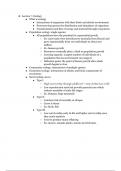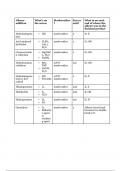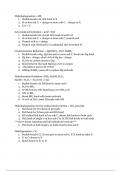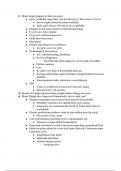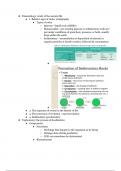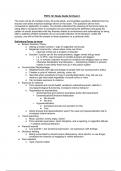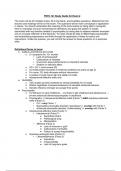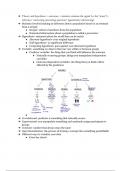Yale University
Latest uploads at Yale University. Looking for notes at Yale University? We have lots of notes, study guides and study notes available for your school.
-
796
-
1
-
25
All courses for Yale University
- MANEGEMENT 101 1
- MB 101_Bloomberg Answers - Economic Indicators Harvard University 1
- Med SURG 2 Final HESI review 2020 Yale University 1
- MED SURG 2 Respiratory and Renal study guide Yale University 1
- Medical-surgical nursing 10th edition 2
- Medical-surgical nursing, 10th Edition : assessment and management of clinical problems 1
- MGMT 2 MGMT2 1
- Microeconomis 1
- MIS 589 1
Popular books Yale University
Latest notes & summaries Yale University
This study guide provides an overview of ecology, the interactions between organisms and their environment, and the distribution and abundance of species. It covers population ecology, community ecology, and ecosystem ecology, highlighting the concept of carrying capacity and survivorship curves. The guide also discusses the evolution of life, including the early Earth environment, the origin of life, and the evolution of multicellularity. The study guide explores animal phylogeny, sex selection...
This study guide summarizes the key aspects of alkene addition reactions, including the reagents used, the regioselectivity (Markovnikov or anti-Markovnikov), and the products formed. The guide provides a concise summary of the reactions, with a focus on the functional groups added to the alkene and the stereochemistry of the addition. The reactions covered include hydrohalogenation, acid-catalyzed hydration, oxymercuration-reduction, hydroboration-oxidation, hydrohalogenation by free radicals, ...
This study guide covers the mechanisms and steps involved in several chemical reactions, including hydrohalogenation, acid-catalyzed hydration, oxymercuration-reduction, hydroboration-oxidation, hydrohalogenation by free radical chain reaction, dehalogenation, halohydrin formation, hydrogenation, ozonolysis, and halogenation. Each reaction is described through a series of numbered steps, detailing the formation of new bonds, the movement of electrons, and the addition or removal of functional gr...
This study guide provides an overview of the significant improvements in various fields over the last 100 years, including increases in life expectancy, reductions in child labor, and advancements in technology. It also discusses the concept of planetary boundaries and the impact of human activities on the planet. The guide then transitions to the importance of water and the evolution of life, highlighting the role of cyanobacteria and the Great Oxygenation Event. The evolution of land plants an...
This study guide covers key topics in paleontology and related fields. It begins by discussing rock types and ages, followed by the history of life and evolution. Taphonomy, fossilization, and different types of fossils are described. Ecology, biotic interactions, and the concept of natural selection are covered. Extinction, dating methods, and sedimentary facies are also mentioned. The guide discusses zone fossils, communities, and provinces in ecology. (Paleo)ecology, including ecological syst...
This study guide covers the fundamental concepts of ecology, including the definition of ecology, the diversity of species, and the structure of communities. It introduces the concept of biomes and their distribution across the Earth, as well as the factors that influence these distributions. The guide discusses the importance of nutrients and energy flow in ecosystems and the role of biogeochemical cycles. It also explores population dynamics, including the factors that influence population gro...
This study guide covers topics related to externalizing behaviors, mental illness, and the criminal justice system. It defines key terms such as Conduct Disorder, Oppositional Defiant Disorder, and Antisocial Personality Disorder, highlighting their symptoms and diagnostic criteria. The guide discusses the Broken Windows Theory and Concentrated Disadvantage, explaining how they contribute to crime and violence in communities. It also explores the impact of exposure to violence, harsh parenting, ...
This study guide provides an overview of the key concepts and theories related to psychopathy, callous-unemotional (CU) traits, and antisocial behavior. It defines CU traits and their association with conduct disorder and psychopathy. The guide discusses the heritability of CU traits and the role of genetic and environmental factors in their development. It also introduces the concept of psychopathy, including its two factors: interpersonal-affective traits (Factor 1) and impulsive-antisocial tr...
This study guide focuses on statistical concepts related to hypothesis testing and analysis of variance (ANOVA). It discusses the importance of understanding different types of errors, such as Type I and Type II errors, and the trade-off between them. The guide also addresses the issue of "p-hacking," where the choice of statistical analyses is based on achieving significant results rather than following a pre-determined plan. It then introduces linear regression as a tool for making predictio...
This study guide provides an introduction to statistical concepts and their application in hypothesis testing and data analysis. It covers key terms such as variables, hypothesis testing, and different types of visualizations for data presentation. The guide explains how to calculate and interpret various measures of central tendency, dispersion, and transformation. It also introduces the concept of sampling distributions and confidence intervals, emphasizing the distinction between descriptive ...

